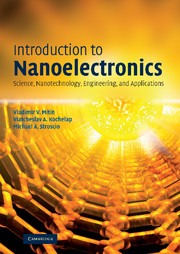Book contents
- Frontmatter
- Contents
- Preface
- List of notation
- 1 Toward the nanoscale
- 2 Particles and waves
- 3 Wave mechanics
- 4 Materials for nanoelectronics
- 5 Growth, fabrication, and measurement techniques for nanostructures
- 6 Electron transport in semiconductors and nanostructures
- 7 Electrons in traditional low-dimensional structures
- 8 Nanostructure devices
- Appendix: tables of units
- Index
7 - Electrons in traditional low-dimensional structures
Published online by Cambridge University Press: 05 June 2012
- Frontmatter
- Contents
- Preface
- List of notation
- 1 Toward the nanoscale
- 2 Particles and waves
- 3 Wave mechanics
- 4 Materials for nanoelectronics
- 5 Growth, fabrication, and measurement techniques for nanostructures
- 6 Electron transport in semiconductors and nanostructures
- 7 Electrons in traditional low-dimensional structures
- 8 Nanostructure devices
- Appendix: tables of units
- Index
Summary
Introduction
Now, we begin our analysis of novel developments in electronics that have resulted from the use of nanostructures in modern electronic devices. Importantly, the attributes of nanotechnology make it possible to pursue both devices with smaller dimensional scales and novel types of device. Though the ongoing trend of miniaturization in electronics is extremely important, the unique properties of electrons in nanostructures give rise to novel electrical and optical effects, and open the way to new device concepts. The electric current and voltage in a device are determined by two major factors: the concentration and the transport properties of the charge carriers. In nanostructures, these factors can be controlled over wide ranges. In this and the next chapter we will study nanostructures for which these basic factors that are important for the electronics are engineered, which are being exploited intensively both in research laboratories and in practical nanoelectronics.
To distinguish the nanostructures already having applications from the newly emerging systems, we refer to the former as traditional low-dimensional structures.
Electrons in quantum wells
In this section, we consider a few particular examples of nanostructures with two-dimensional electrons.
As a basis for the further analysis, we will recall and develop several of the previously introduced definitions and properties of an electron gas. In what follows, the effect of the band offset arising at a junction of two semiconducting materials, which was defined in Section 4.5 via electron affinities, is critically important.
- Type
- Chapter
- Information
- Introduction to NanoelectronicsScience, Nanotechnology, Engineering, and Applications, pp. 218 - 241Publisher: Cambridge University PressPrint publication year: 2007



